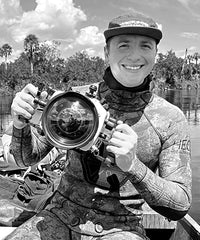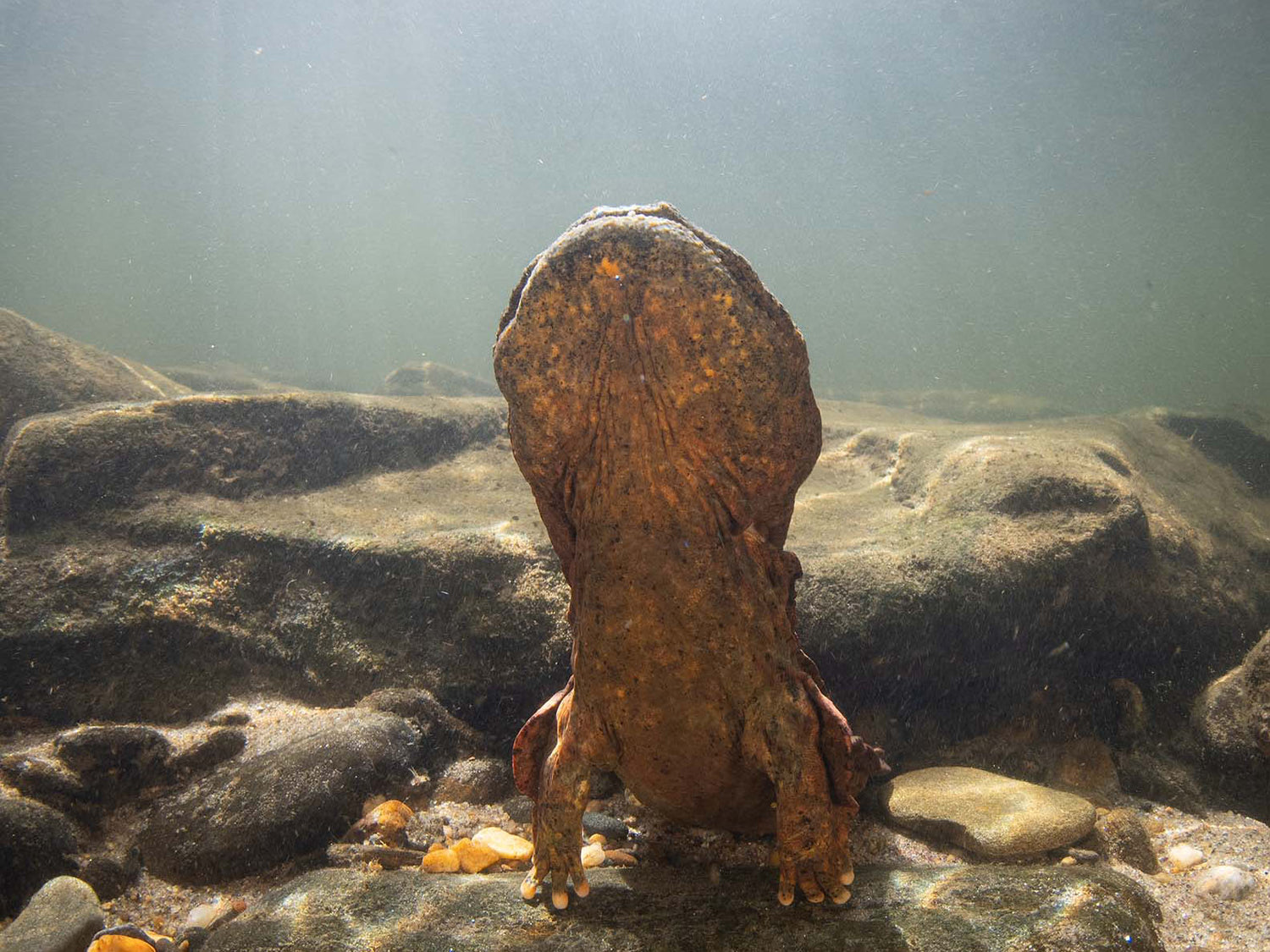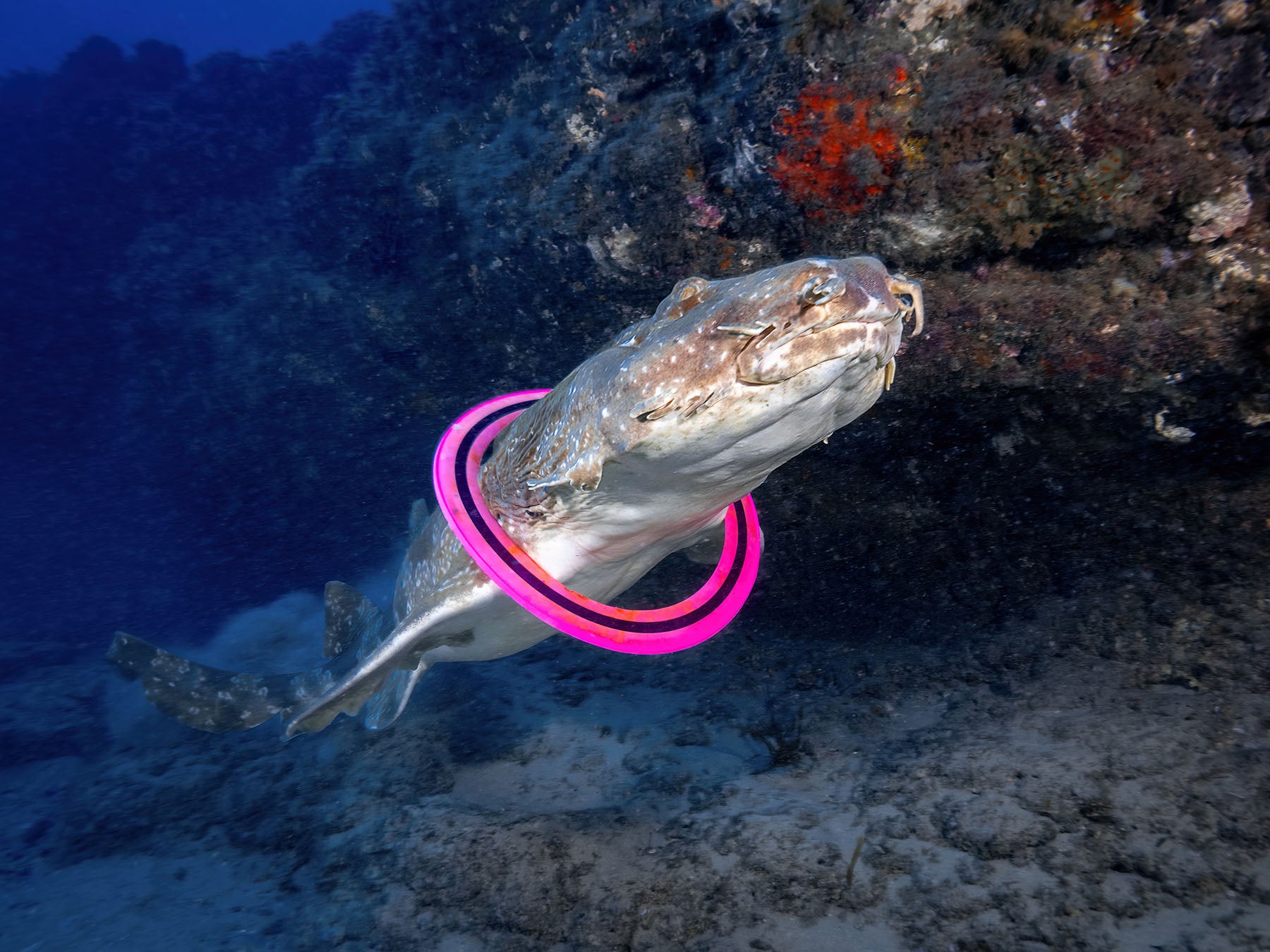Hellbenders are these weirdly compressed, slimy salamanders the size of a large hoagie sandwich. Their skin is warped and their eyes are bulging. There is nothing that looks quite like them. They spend most of their time hidden under large rocks in fast flowing rivers but for a couple of weeks every year, they emerge for their annual mating rituals. Large males guard den rocks from subdominant males. Females search for optimal mates and spawn deep within the dens. All of the hormones given off lead to some very interesting behaviors from the largest salamander in North America.

A subdominant male challenges the denmaster. Whoever claims the den will have the best odds of mating with a female. This necessary pursuit can lead to violent endings. © Bill Hawthorne
Hurry Up and Wait: Searching for Hellbenders
For the past three years, I have travelled up to North Carolina to photograph hellbenders during their mating season. The trip usually begins with some intensive scouting; we hike up and down fast flowing, clear water, forest streams with our masks and snorkels. We look for refrigerator sized rocks, parallel to the flow, and poke our heads underwater to hopefully see the iconic hellbender smile looking back up at us. Hellbenders utilize these large flat rocks as den sites as they provide the optimal amount of flow, and protection from predators, to spawn. Once we have found a few dens, we begin to setup for photography. The water is about 61°F (16°C) which may not seem too cold but the high flow and necessity for little movement means that you can get quite cold, quite fast. Learning from mistakes in the past, I brought with me an 8mm semi dry this year which made all the difference. The water depth is only a couple feet, but the thick wetsuit and rapid flow makes staying stationary very difficult. So, I threw a 40lb weight belt around my waist, left my fins in the car, and jumped in the water.
Immediately I remembered why I drove hundreds of miles, negotiated rapids and cold water, and managed dozens of pounds of gear. The clear water streams of Appalachia are stunning. Small minnows dance around sunset-colored rocks. Crayfish navigate through the current. Mussels feast upon microorganisms in the water column. And goofy faced salamanders peer up from rocky bottom.
Most salamanders are a few inches long, brightly colored, and look like they were designed by an artistic minimalist. Hellbenders can be up to two feet long, colored like the streamside rocks, and look like someone accidentally sat on a lizard. They are these bizarre animals with skin like lasagna and a face that is the epitome of cute. Despite the high current and threat of predators, hellbenders do a lot of sitting around. Most days snorkeling consisted of hours of staring at an individual waiting for it to make a move – sometimes, they never did.

The denmaster takes a moment to stretch during a lazy day in the river. © Bill Hawthorne
On this trip, I had asked Ikelite if I could demo their Sony a7CR and DLM/A housing. This set up is significantly smaller and higher resolution than my go-to Canon R6. I was eager to try the set up as the small size meant I could get lower and closer to the hellbenders and it would be significantly easier to traverse through the fast flowing streams. As soon as I opened the box, I knew how much of an improvement this would be.
I ended up spending about 20hrs over 4 days in the water watching hellbenders. I would climb in the water early morning, glue myself near a den, and wait for some action to take place. Most of the time, a den master would be guarding his rock while another male waited close by. The subdominant male would occasionally challenge the den master and earn himself a nip. But most frequently, they spent their time motionless, waiting for a female to arrive. I spent hours waiting and observing and saw some behaviors that were completely new to me.

A large hellbender peels its skin off like a glove. Similar to snakes, hellbenders shed their skin. As hellbenders respirate through their skin, this allows them to breath more efficiently. As an added bonus, the skin also serves as a nice snack. © Bill Hawthorne
The Drama of the Den Master
I saw dozens of males during the trip, but only a few females. But when they were in the area, everyone was aware. After waiting for hours, suddenly, more males began showing up around the den. Movements would become more frequent, and territory was guarded fiercely. A female would come tromping down – swollen like an eggplant from all of her eggs. She would approach the den master, and they would have an intense stare down. After deciding she wasn’t a challenging male, the den master would grant her entry to the den. You would never know there were giant salamanders undeath the rock except for the occasional sand cloud that would come rolling out. The subdominant males would seize this opportunity, trying their best to crawl into the den and fertilize some of the eggs for themselves, this often resulting in the den master chasing them out and giving them a good bite. But what actually happened inside the den, only the salamanders know.


A small hellbender gazes longingly at a beautifully chosen den before approaching. The denmaster will need to determine if the aggressor is a male he will need to fight or a female he can mate with. © Bill Hawthorne
Getting Low and Close with the Sony a7CR DLM/A Compact Housing
The Sony a7CR and Ikelite DLM/A ended up being the perfect combination for the trip. The small size meant I could get down to eyelevel between large rocks and hold it in the high current without much difficulty. Sediment made flash photography difficult but I found a nice balance by bringing the strobes way back and using a slow shutter speed. It really made me realize the value of small set ups. I could position the camera between rocks and very low to the ground. I didn’t get tired or sore from carrying it around and it made the experience much more enjoyable. Not only that but I believe the smaller housing would motivate me to use my camera much more often. It is far more enjoyable and significantly easier to travel and hike around with it. I think people often undervalue the importance of size, however, in this scenario, it seemed like one of the most important factors.
I ended up shooting the a7CR with a metabones adapter, my trusty Canon 8-15 f/4 fisheye behind an Ikelite 6 in dome port, and dual Ikelite DS232 Strobes. I loved the set up. The resolution was mind boggling, and the autofocus was very reliable even with lots of sedimentation in the water column and a non-native lens. I loved everything about the set up but occasionally found myself missing the faster shooting speeds and larger buffer of my Canon R6.

A photograph of me and my camera setup by my good friend Matt Sullivan. The small setup was a godsend in the high current while photographing low lying hellbenders. © Matt Sullivan
Catching the Action with TTL Converter and Rear-Curtain Sink
Since I started photographing hellbenders, I have dreamt of an opportunity to photograph a slow shutter speed image of a fight. I utilized Ikelite’s TTL converter to shoot with rear-curtain sink, allowing me to capture motion and then freeze the subjects. Photographing hellbenders is a lot of sitting around and waiting. When action does happen, it is often very quick and very dramatic. After the four days spent in the water, I only had one opportunity to photograph a true fight. When I was least expecting it, two hellbenders came rolling down the river, locked jaws, and I was able to capture a frame that I had envisioned for years prior. There is lots of room for improvement but am very happy with how it turned out. For an animal that breathes through its skin and is so sensitive to water quality and habitat changes, it is spectacular to see how violent they can be.

Two hellbenders, locked mouth-to-mouth, roll down the river in a brawl reminiscent of dinosaurs. © Bill Hawthorne
The Hellbender: An Icon of American Biodiversity
The streams of Appalachia are reminiscent of times forgotten; filled with animals you’d only expect to see in the Amazon rainforest and natural history museums. If you can brave the cold, you’ll experience a world of shimmering fish, ancient stones, and giant salamanders. It is a place full of struggle and competition, where you are reminded of the constraints of instinct and primal drives. The hellbender is an icon of American biodiversity, a testament to the endurance of evolution, and a truly spectacular subject to photograph.

Bill Hawthorne is an aquatic ecologist specializing in the study of the freshwater springs of Florida. Bill focuses his studies and photography on freshwater species, most notably turtles. By sharing his underwater images, Bill hopes he'll expand his viewers' passion toward these unique environments and animals. Check out more of his work on his website, Instagram @billhawthornephotography, TikTok, and YouTube.
Additional Viewing
HELLBENDER Underwater Results with the Canon RF 10-20mm F4L Lens [VIDEO]
A Review of the Canon RF 10-20mm for Underwater Photographers & Videographers
What Secrets Lurk Underwater in the Florida Springs at Night?
Featured Customers | Bill Hawthorne The Turtles of Florida
Sony a7C II & a7CR // DL vs DLM Ikelite Underwater Housing [VIDEO]













![Protect Sea Turtles with a Postage Stamp! [VIDEO]](http://www.ikelite.com/cdn/shop/articles/ikelite-David-Fleetham-turtle-postage-stamp.jpg?v=1730230372&width=1536)